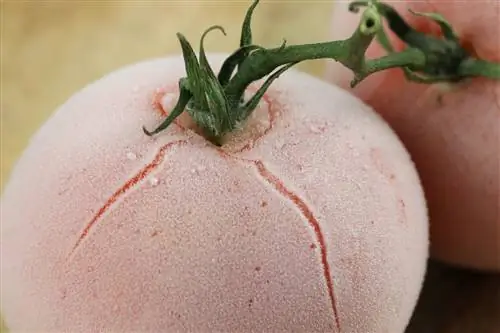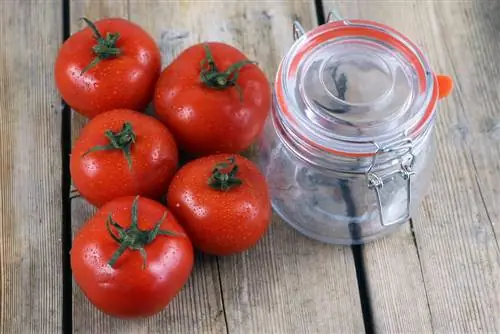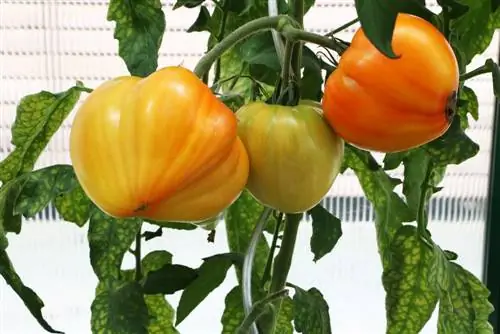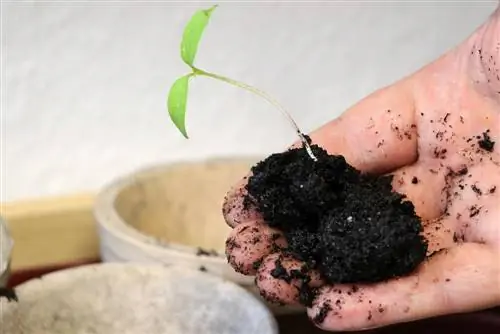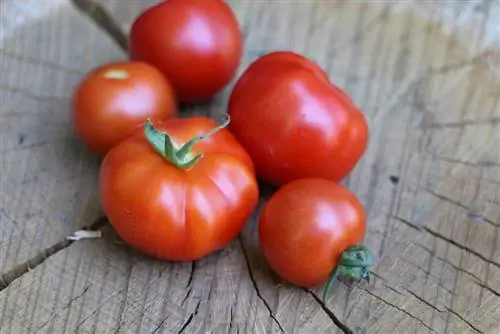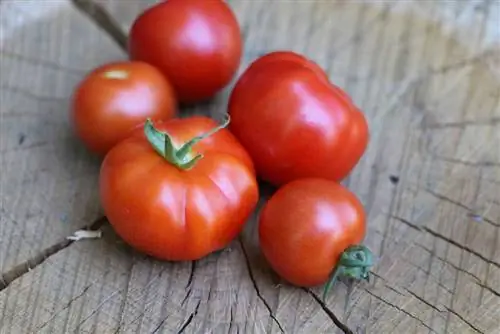- Author admin [email protected].
- Public 2023-12-17 03:39.
- Last modified 2025-06-01 06:48.
You want to enjoy the tasty tomatoes from your own garden all year round. But they are usually harvested and consumed straight away, or processed into ketchup or preserved tomatoes. The fresh taste can be preserved by simply freezing the harvested tomatoes and defrosting them in portions. It's not a difficult path from a small plant to a fresh tomato from the freezer, as tomatoes are suitable for every garden, but also for the balcony, thanks to their fast growth, low maintenance requirements and variety of varieties.
Grow tomatoes in your own garden
You can buy the plants at the nursery or grow them yourself from seeds. Up to a size of 25 to 30 centimeters, it is advisable to place the tomato plant on the windowsill in the house and give it a sunny and warm place. The seedlings are grown individually in small flower pots, are not allowed to dry out and should receive a constant climate. If you want to sow tomatoes directly in the garden, you should wait until the end of March before sowing and prefer sowing in a greenhouse. As long as there is still night frost and ground frost, the small and delicate plants are exposed to the risk of freezing to death. Complete planting outdoors should not take place before May. To promote impressive growth and a rich harvest, prepare the planting correctly and follow the sequence:
- find a sunny location
- Dig up soil
- Insert tomato plant with soil from the pot
- water lightly
- Press earth
- first fertilization after a week.
Tomato plants need a location protected from the weather and plenty of nutrients. Fertilization is not only necessary for the high fruit level, but also for the resistance of the plant
Which tomatoes are ideal for freezing
The variety plays a minor role in the decision. So you can choose the type of tomato that tastes best and is based on your own ideas based on size and shape. It is important that the tomatoes intended for the freezer are still firm and do not have any soft or rotten spots. However, they must no longer be green, but must have completely completed the ripening process. Since tomato plants continue to produce new fruit throughout the summer, freezing them in portions is particularly easy. Required:
- the ripe and firm tomatoes
- Freezer bags or ice cube trays
- Clips.
Tomatoes can be frozen whole or in sliced form. The following steps are necessary before placing the tomatoes in the freezer bag:
- wash and dry properly
- Cut out the stem base
- Cut tomatoes into slices or cubes if necessary
- Seal the bag airtight.
Properly packaged, the tomatoes can stay in the freezer for up to 12 months. Since their consistency tends to be mushy after thawing, they are best suited for further processing in soups, sauces or pesto. The firmer the fruit, the firmer the consistency will be even after thawing. Small varieties in particular are ideal and can easily be frozen whole and stored for the cold season.
Freezing instructions
You have to wash and dry the tomatoes well. The stems are then cut out in a cone shape. Depending on your wishes, the tomatoes can be chopped up.
Fresh tomatoes are only partially suitable for freezing. This is due to their high water content. The sap expands when it freezes and bursts the cell walls. The fruits are mushy after thawing and can only be used for sauces and soups. However, it is a very quick variant.
Tomatoes lose their flavor in the cold. You shouldn't keep fresh tomatoes in the fridge. You should just try it out and form your own opinion. Many garden owners use this preservation option regularly every year and are very satisfied. Frozen tomatoes have a shelf life of 10 to 12 months, exactly until the next harvest.
The best thing to do is to chop up the tomatoes and bring them to the boil, adding the seasoning straight away. This takes about 10 minutes. Let the mixture cool and then freeze it in portions.
Another option is to chop the tomatoes, cook them briefly and then pass them through the liquor. The tomato sauce or puree can be poured into ice cube trays or even ice cube bags. This way you can easily portion it and remove it individually.
Freezing tomatoes is not the best way to preserve them, but it can be used. After defrosting, you can no longer use them for tomato mozzarella, but you can use them for soups, sauces, casseroles and the like.
Alternatives - preserving tomatoes
Tomato varieties that contain more pulp and fewer seeds, such as Roma and beef tomatoes, are particularly suitable for preserving or preserving. You also have to pay attention to he althy fruits!
Dried tomatoes
The tomatoes are halved. Then you remove the core and the stem base. The halves are placed on a baking tray and sprinkled with a little s alt. This helps draw water. The oven is set to around 40 to 50 °C. The tomatoes need 8 to 12 hours to dry. It is important that the oven door remains ajar so that the moisture can escape. The best thing to do is to jam a wooden spoon into the door. The dry tomato pieces can also be layered in screw-top jars. Pour good olive or rapeseed oil over the fruit. Close jars tightly!
Pickled Tomatoes
Tomatoes can be easily pickled in vinegar. Small tomatoes, such as cherry and cocktail tomatoes, are suitable for this. The fruits must be of the best quality. You put them in jars with screw caps. Then good wine vinegar is diluted in half with water. Add sugar and spices and, if desired, onion, s alt, pepper, garlic, chili or similar. Everything is brought to the boil and then poured over the tomatoes. The jars must be closed tightly immediately.
Cooked tomatoes
The traditional way of preserving is still very popular. The clean tomatoes are removed from the stem and seeds. Cut the fruit in half and pierce the skin with a toothpick. Then you can put the fruit in mason jars. They are poured over with s alt water, which has to boil once. The jars are then quickly sealed and sterilized at 80 degrees for 45 minutes. This works best in a pressure cooker.
You can also preserve tomato sauce this way.
Proper care avoids pests and plant diseases
Tomatoes are generally very resistant to pests and diseases. However, they can be attacked by the fungus if they are kept too moist, planted in a location that is too shady, or simply placed too close together. Even if only the plant and not the fruit appear to be affected by whiteflies or fungus, tomatoes from infected plants are not suitable for storing in the freezer. They are just as affected by the disease of the plant as the plant itself and could still cause he alth problems if consumed even after freezing. Fungal infestation should not be confused with powdery mildew, which can be seen on some plants in the morning hours, especially in late summer. Before making a diagnosis, the gardener should wait until midday and then check whether the light film on the plant has disappeared. If it is mildew, it is no longer visible at the first rays of sunlight and is dried by the sun. Since tomatoes require a lot of nutrients, regular fertilization is the basis of he althy and beneficial care. The gardener should not be too economical when watering, but should avoid waterlogging.
Tomatoes from your own garden - tasty and he althy benefits
Rich in vitamins and tastier than store-bought tomatoes, the plants grown in your own garden or on the balcony are truly organically grown and cared for. In order to give tomatoes the nutrients they need for plenty of fruit and strong, he althy growth, the gardener does not have to use chemical fertilizers and can easily use organic fertilizer. This means that the tomatoes harvested are naturally free of artificial ingredients and are therefore particularly he althy. If you want to harvest the same plants all year round and have not only frozen but also fresh tomatoes on hand, you can dig up the plants in autumn and overwinter them indoors. The darker the location you choose, the cooler it has to be. In a sunny window or in the winter garden, the plants bear fruit all year round and can easily be planted outdoors again in the spring and exposed to the summer sun.

